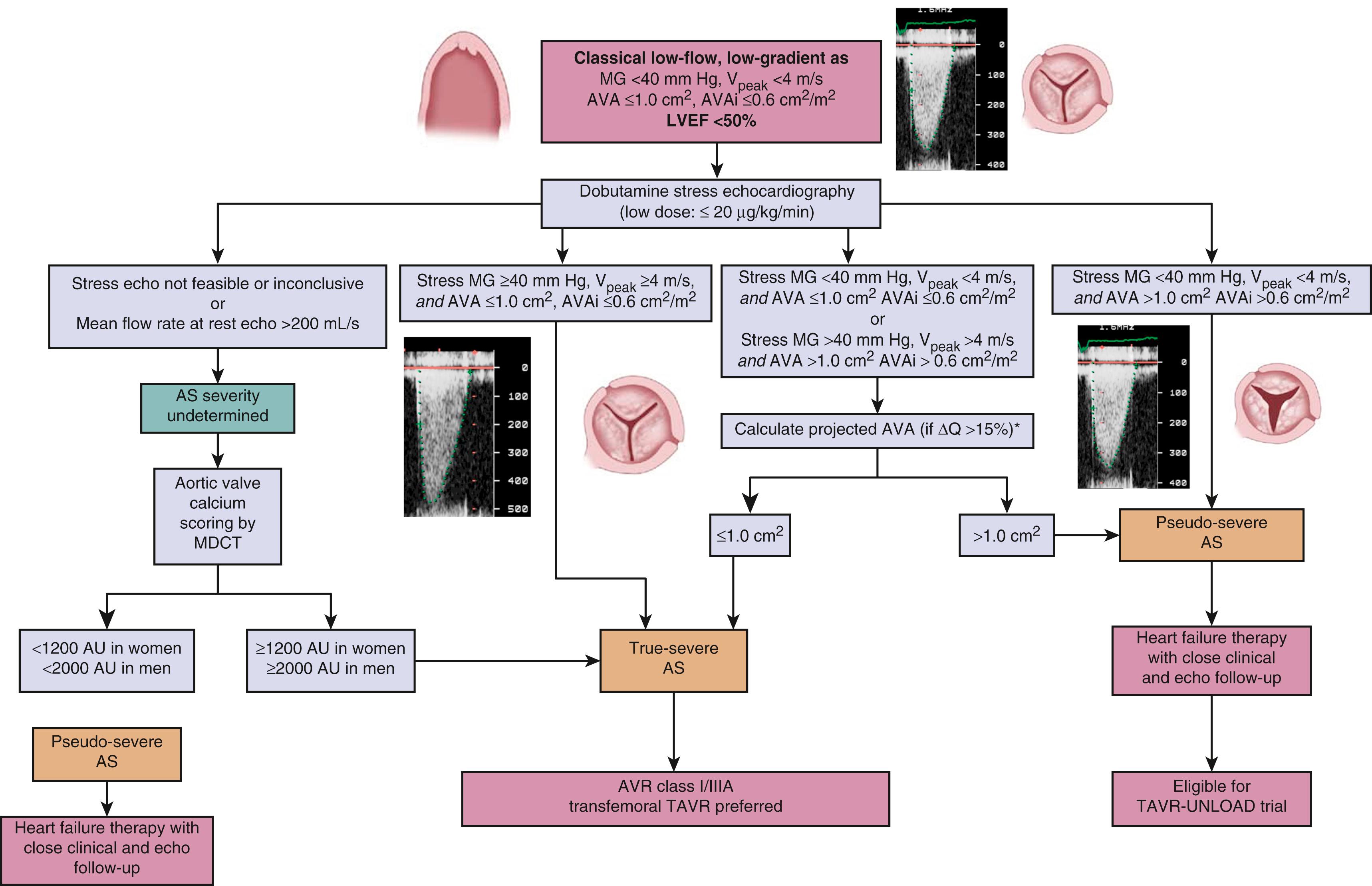Physical Address
304 North Cardinal St.
Dorchester Center, MA 02124
Low-flow, low-gradient (LF-LG) aortic stenosis (AS) with reduced left ventricular ejection fraction (LVEF) occurs in approximately 5% to 10% of patients with AS. This entity is characterized by a small aortic valve area (AVA) compatible with severe AS (i.e., ≤1.0 cm 2 and/or ≤0.6 cm 2 /m 2 ) combined with low mean transvalvular gradient (MG i.e., less than 40 mm Hg), a low LVEF (i.e., <50 %), and a low-flow state (i.e., stroke volume index [SVI] <35 mL/m 2 ; ![]() ). , It is also commonly referred to as classical LF-LG or stage D2 AS and represents one of the most challenging subsets of patients in terms of diagnosis and treatment. The left ventricular (LV) systolic dysfunction and ensuing low-flow state could result from an afterload mismatch , caused by the AS or from the combination of a preexistent myocardial disease and AS. The main diagnostic challenge in LF-LG AS with low-LVEF is to distinguish true-severe from pseudo-severe (i.e., incomplete opening of a moderately stenotic valve caused by a low-flow state) stenosis. The distinction between these two entities is crucial for therapeutic decision making. Patients with true-severe AS generally benefit from aortic valve replacement (AVR), whereas those with pseudo-severe AS may not. The prognosis is usually poor (3-year survival rates <50%) in patients with LF-LG treated medically, and operative mortality after surgical aortic valve replacement (SAVR) is high, ranging between 6% and 33% depending on the presence or the absence of LV flow reserve and other comorbidities. Precise assessment of both the severity of AS and the degree of myocardial impairment is crucial for optimal risk stratification and therapeutic management in patients with LF-LG AS and reduced LVEF.
). , It is also commonly referred to as classical LF-LG or stage D2 AS and represents one of the most challenging subsets of patients in terms of diagnosis and treatment. The left ventricular (LV) systolic dysfunction and ensuing low-flow state could result from an afterload mismatch , caused by the AS or from the combination of a preexistent myocardial disease and AS. The main diagnostic challenge in LF-LG AS with low-LVEF is to distinguish true-severe from pseudo-severe (i.e., incomplete opening of a moderately stenotic valve caused by a low-flow state) stenosis. The distinction between these two entities is crucial for therapeutic decision making. Patients with true-severe AS generally benefit from aortic valve replacement (AVR), whereas those with pseudo-severe AS may not. The prognosis is usually poor (3-year survival rates <50%) in patients with LF-LG treated medically, and operative mortality after surgical aortic valve replacement (SAVR) is high, ranging between 6% and 33% depending on the presence or the absence of LV flow reserve and other comorbidities. Precise assessment of both the severity of AS and the degree of myocardial impairment is crucial for optimal risk stratification and therapeutic management in patients with LF-LG AS and reduced LVEF.
Video 82.1. Low-flow, low-gradient aortic stenosis (AS) with reduced left ventricular ejection fraction is characterized by a small aortic valve area compatible with severe AS (i.e., ≤1.0 cm 2 and/or ≤0.6 cm 2 /m 2 ) combined with low mean transvalvular gradient (MG; i.e., <40 mm Hg), a low LVEF (i.e., <50%), and a low flow state (i.e., stroke volume index <35 mL/m 2 ).
Low-dose (5–20 μg/kg/min) dobutamine stress echocardiography (DSE) has been shown to be useful to distinguish true-severe from pseudo-severe AS ( Fig. 82.1 ). For this purpose, it is recommended to use longer DSE stages (5–8 minutes) with infusion of dobutamine during 3 to 5 minutes and then acquisition of images once heart rate and hemodynamics have reached a steady state. The LV outflow tract diameter is considered constant during DSE. , Assessing the severity of LV dysfunction usually relies on the magnitude of contractility improvement during DSE (i.e., contractile reserve).

Become a Clinical Tree membership for Full access and enjoy Unlimited articles
If you are a member. Log in here